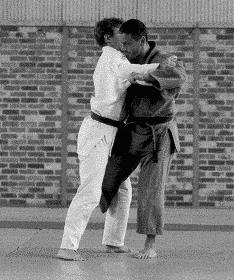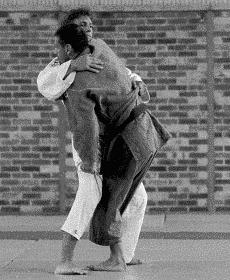1. Kuzushi - the breaking of balance or crumbling of structure

2. Tsukuri - entry, or building the relationship archtecture of a throw.

3. Kake - execution of the technique.

Sloan Sensei recently wrote a post on the this classical view.
Kyle Sloan's excellent article
While this classical analysis of a technique is correct, I do not feel like this is the way we should teach our minds the way a throw works.
In Waddell Sensei's old dojo there was a lot of talk about forgetting the kake, or execution part of the technique. If you created off balance, and fit in properly, kake or execution happened automatically. There was once a Jiyushinkai bumper sticker that said, "Kake Happens".
Another thing I have noticed in my years of trying to throw people is that the first technique rarely works. Against higher level players the first technique NEVER works. So in the gospel according to me the dynamics we should train our minds to search for is...
Kuzushi, Tsukuri....Kuzushi, Tsukuri.....Kuzushi, Tsukuri....and then uke falls when he decides he can't stand any more.
The Kake mentality, the idea we actually have to execute a throw, is what makes much of the judo world blast with power. It is what makes the Aiki world crank joints and collide with energy.
In order to do the techniques at higher technical and philosophical levels...
We cannot make kake. Kake happens.







Exactly right! There are different ideas about how the throwing thing works - three common ones...
ReplyDelete1) kuzushi-tsukuri-kake
2) kuzushi-tsukuri-kuzushi-tsukuri
3) kuzushi-kuzushi-kuzushi
In judo I tend to work in the first two paradigms. In aikido I tend to work in the second two paradigms.
Something I noticed was that the more intent you put into any of the three stages, the more difficult it is to move to do a follow-up technique.
So, if youre working paradigm 1 and you put a lot of intent into kake, it's harder to shift to the kuzushi of another technique.
In paradigm 2, the more intent you put on tsukuri, the harder it is to move to another throw.
Thus, the ideal is (seems to be) paradigm 3 - just move, evade, and kuzushi until uke cannot sustain his own weight/position/momentum.
One of my students one time called that, "The art of pretending you meant to do that."
Great article!
Yeah, great stuff. I agree. Sometimes I refer to it as putting the guy on the edge of a cliff. If he falls off, great. If not, I use his recovery to put him on the edge of another cliff and see if he falls off that one, and so on.
ReplyDeleteNick has has quoted (from somewhere) that the human brain can't deal with more than 4 or 5 problems in a row. Problem #1, he can handle, same with #2, but 3 starts to break him down, and certainly 4 and 5 are usually past his ability to keep up (depends on their level). The worst thing we could do if a "throw" fails, is start over and re-set. Move to the next kazushi/tsukuri; he gets out, move to the next one, etc.
Aikido, same way. Nick also mentioned at the playday that you may not want to let the guy off the hook arbitrarily or prematurely, either. He may not have fallen down, BUT he's still in kazushi, and you may still have tsukuri. Sometimes holding him there will make him fall EVENTUALLY, or make his efforts to really get out of it much more dynamic. (If that makes any sense...)
I agree. Thanks for linking to my article above.
ReplyDeleteKuzushi is really where it's at. Kake is a natural by-product of proper kuzushi & tsukuri. If you have to exert a lot of effort in order to throw your partner, you're doing it wrong.
tsukuri "fitting" could be considered the primary aiki function as well-- there is even a nice case for considering that before you make physical contact with uke you can effect kuzushi by doing tsukuri --there is a nice closing with a spiral exercise that demonstrates this and winds up causing the attacker to slip into walking backwards for you-- so that in effect kuzushi has begun long before you lay a hand on him (this spirial tsukuri ploy is not kuzushi in the classic sense of postural distortion of hips, shoulders, and root, but kuzushi in the wider sense of causing the person to make moves they had not planned to make)
ReplyDeleteanother example of pre kuzushi tsukuri is Eric slipping up Behind the disturbed guy last week before making contact with him -- interupting his assult by catching his wrist from behind or even just catching their attention from the side provokes uke to start rotating (again a big advantage since spinning people tend to spin down) tsukuri (strategic positioning in this case) provides distinct advantages in creating the circumstance for kuzushi to be magnified and decisive (this is often why kuzushi and kake get to be the same thing-- the initial physical contact of kuzushi becomes the whole deal--throwing on contact)
so it is probably wise to consider that tsukuri preceeds kuzushi whenever possible
(ie if ya see it comming, you can get the difference)